Part Two: Hazardous Earth Processes
Lab 7 Reading: Landslides
Landslides
Objective: Use an understanding of slope resisting and driving forces to determine the risk of slope failure.
Risk Assessment:
Risk assessment is a term used when scientific probabilities are used in decision making. Because science is contingent and probabilistic knowledge, scientific investigations can never prove that one decision is absolutely better than another. Instead, science provides a framework for decision makers or stakeholders to make an informed decision based on the probability of one out come or another. To make this more concrete, take a look at the map below.

Digital Compilation of “Landslide Overview Map of the Conterminous United States: East Central Region” (U.S. Department of the Interior / U.S. Geological Survey)
If you look at the legend, the delineations are broken up into “Landslide Incidence” and “Landslide Susceptibility/Incidence.” This shows that the data presented in this map come from two different sources of information. “Landslide Incidence” is based on actual data of the number of recorded landslides. All of the areas with a beige, orange, and red have a high frequency of recorded landslides. The colors (beige, orange, and red) represent how big of a landslide each area has had in the past.
Where less data on the actual frequency of landslides exists, the “susceptibility” of a landslide is shown. These are the turquoise, light brown, and pink areas. However, actual measurements of landslide incidence are not known for these areas: “susceptibility” is a subjective term based on “anomalous precipitation or changes in existing conditions can initiate landslide movement in rocks and soils that have numerous landslides in parts of their outcrop areas.” This means that the USGS scientists who put together this map did not actually go out and test each and every square inch of slope in these areas, but instead made some generalizations about these areas based on scientific observations and information they have about conditions and that cause slope failure.
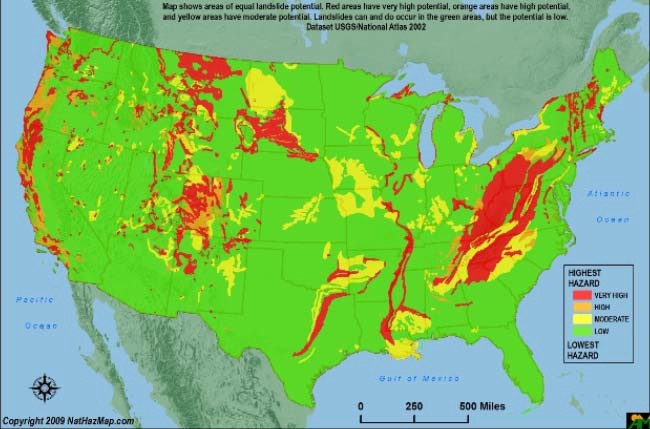
Compiling both data sets of (1) actual frequencies of slope failures and (2) observations of slopes gives us the map on the previous page. Policy makers will then take this information and create the “Risk Assessment” map to the right, which shows to the public the possible risk of experiencing a slope failure based on location. Note how the scientific terms of “incidence” and “susceptibility” are now replaced by hazard risks of “very high” to “low.” Policy makers and stakeholders (e.g., land owners or insurance companies) can then use the information to decide where to build a house, shopping mall, road, or other structure.
Driving and Resisting Forces:
Slope failure, the downslope movement of earth materials, is caused when resisting forces within the slope are overcome by the driving force on the slope. The main driving force is gravity, the force which attracts objects to the center of the Earth. The main resisting force is the strength of the slope, which is more than just the frictional resistance of the earth materials. It is more than just frictional resistance because there are different types of slopes: consolidated and unconsolidated.
Consolidated Slopes ‐ The strength of a consolidated slop, a slope made of solid material, is going to be dependent on the strength of the forces holding the consolidated materials together. If the slope is made entirely of granite, for instance, then the resisting force is created by the bonds holding together the feldspar, quartz, and biotite. These are mostly strong covalent bonds that are difficult to break, needing both water and energy like sunlight, acidity, or heat to break. If the slope is made entirely of limestone, then the resisting force is created by the bonds holding together the calcite. These are ionic bonds, which are relatively weak and can be broken in water and more quickly in slightly acidified water.
Another important resisting force of consolidated slopes is confining pressure. Confining pressure is simply the weight of the slope. If you have ever seen a pencil rolling down an uneven desk and stopped it from rolling down by slapping your hand on it, then you know what confining pressure is. By pressing down on the pencil, you added confining pressure or weight. The added weight stopped downward movement of your pencil. This happens on a much larger scale on slopes. The pressure of the overlying rocks or any vegetation adds weight to the slope which makes the slope less likely to move.
While consolidated slopes are inherently strong because they are not broken up, any consolidated slope can be broken apart by weathering processes: chemical, biological, and physical weathering. Chemical weathering (e.g., dissolution, oxidation, and hydrolysis), biological weathering (e.g., penetration by tree roots) and physical weathering (e.g., frost wedging and exfoliation) can break down consolidated materials into unconsolidated materials. In nature consolidated slopes almost always have a weathered part in which active slope failure is occurring. For instance, the tops of steep consolidated slopes of granite or basalt which are exposed to weathering processes are broken up, resulting in rock falls.
Slopes of sedimentary rocks can fail along areas weakened by water infiltration, weathering, and erosion.
Table 1. Examples of consolidated slope failures.
Consolidated Rock Slope Failures ‐
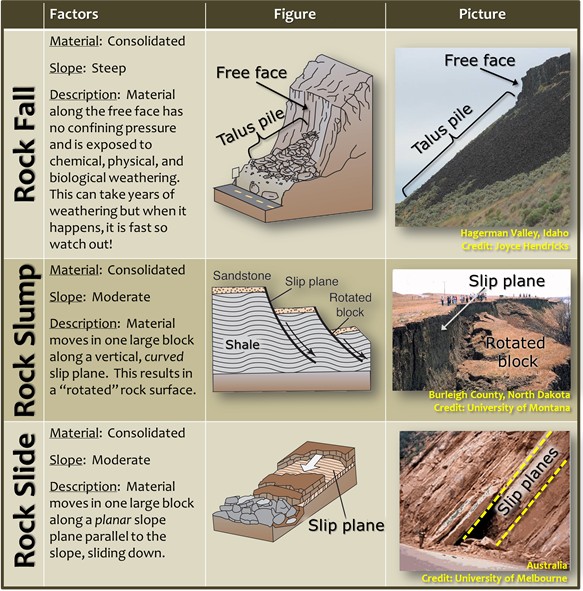
Unconsolidated Slopes ‐ The strength of an unconsolidated slope, a slope made of sediments, is going to be dependent upon the strength of the forces resisting material movement. These consist of both frictional forces and cohesive forces.
Frictional forces act like interlinking puzzle pieces. They resist moving because they cannot move as each piece is stuck in place by the shape of the pieces around it. The more blocky or angular the sediments are, the greater the frictional force; however, the more rounded and smooth the sediments are, the less the frictional force.
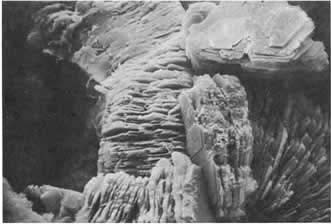
1600 x magnification of clay particles. (Image credit: Steve Thien, Soils and Soil Fertility, 5th edition, Oxford University Press)
Cohesive forces act like glue, holding the sediments together by causing them to stick together. Small amounts of water are necessary for this. Imagine if you got the pages of a book wet. They would stick together due to cohesive forces. This happens especially with clay materials. On a microscopic level, clay particles are described as platy or like flat disks. (See figure above.) When they get wet, they stick together like the pages of a book. Sticking together helps them to resist downslope movement.
Both cohesive and frictional forces can be overcome by large amounts of water. In these cases, the sediments become surrounded by water, negating any frictional or cohesive forces. When this happens with sand, it becomes quicksand.
As with consolidated slopes, confining pressure also helps to the slope to resist moving. Unlike consolidated slopes, vegetation can increase resisting forces: plant roots act as nets, holding unconsolidated sediments together. Plants like trees can also add weight, increasing confining pressure.
The Role of Water – Another major factor in determining slope failure is water: how much and how often. Consider the following two scenarios:
Scenario 1: Small amounts of water over long periods of time can break down or weather consolidated parent material into smaller unconsolidated sediments. A periodic strong rainfalls can erode or remove these sediments from the slope, exposing the consolidated parent material again. This helps to prevent larger slope failures because unconsolidated materials are constantly removed from the slope.
Scenario 2: Small amounts of water over long periods of time can weather consolidated parent material, resulting in deep layers of fine sediments such as clays. These clays can resist movement due to cohesive forces. However, if strong rainfalls are rare, a sudden inundation of the sediments can the break down all cohesive and frictional forces. This results in earth flows.
In both cases, water works to weather sediments, but the timing and amount of larger rainfalls can result in two different slope failure risks. In Scenario 1, it can result in a decreased risk of slope failure; but in Scenario 2, it can result in an increased risk of slope failure.
Table 2. Examples of unconsolidated slope failures.
Unconsolidated Slope Failures –

Table 3. Examples of unconsolidated “wet” slope failures.
Summary:
Landslides or slope failures occur due to many factors. The main factors are given below:
- Type of earth material –The main resisting force is the strength of the slope material. Generally, unconsolidated slopes move more easily than consolidated slopes. Unconsolidated slopes have a lower resisting force.
- Structural properties of earth materials – Especially with consolidated metamorphic and sedimentary rocks, understanding the orientation of foliation of metamorphic rocks or layers of sedimentary rocks is important as it can show how the slope will fail. Foliation and layer breaks can be areas of slope weakness. It is also important to understand if and how a consolidated slope is fractured. Rocks whose weak points are aligned with the slope have a higher risk of slope failure. (See the picture of the rock slide on page four. The slip planes run along the slope.)
- Steepness of slopes – Gravity is the main driving force of slope failure; therefore, higher slopes have a higher risk of failure.
- Water – Understanding the amount and timing of water is important. See previous page for more explanation.
- Ground shaking – The possiblity of ground shaking can be a trigger event for slope failure. This can be natural due to earthquakes or man‐made due to construction.
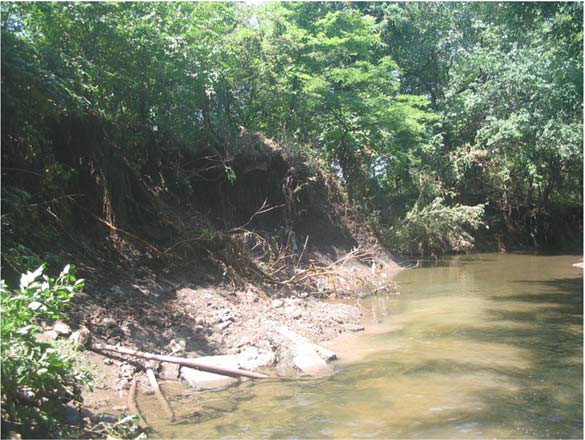
The stream has “cut” into the slope (left) by eroding away the bottom, Johnson County, Kansas (Image credit: U.S. Department of the Interior / U.S. Geological Society / Kansas USGS )
Type of vegetation present – This is two‐fold: vegetation roots can increase the resisting force by holding unconsolidated sediments together and the added weight can increase confining pressure; however, vegetation roots can decrease resisting force by breaking up consolidated rock. In general, deeply rooted plants are better at stabilizing slopes. In some west coast states, shallow rooted plants decrease the resisting forces. These plants add weight to the slope, but are not well anchored and slide downslope. Removing deeply rooted plants, like trees, can decrease resisting forces. This is seen in areas where trees are clear‐cut during logging activities. Proximity to areas undergoing active erosion – This is seen especially along stream banks where the stream is eroding away the bottom of a slope. The slope “overhangs” the stream until the slope fails.

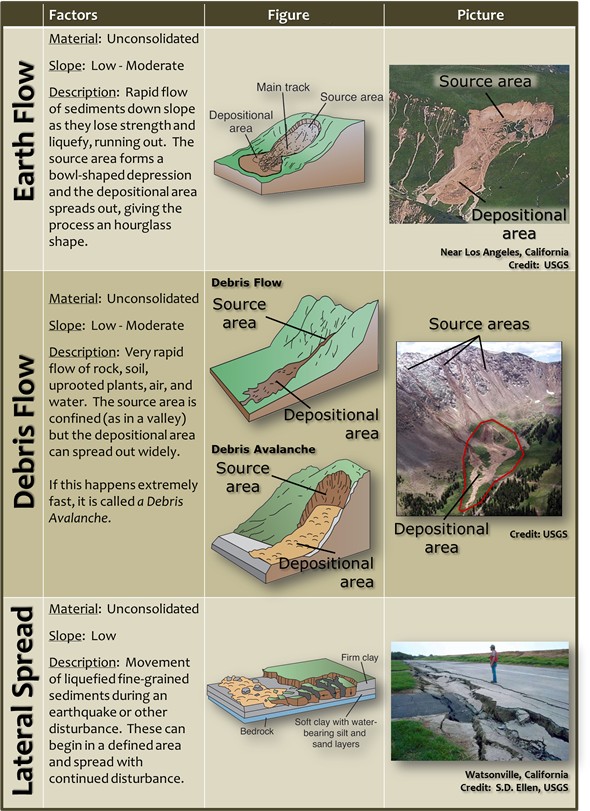

Feedback/Errata